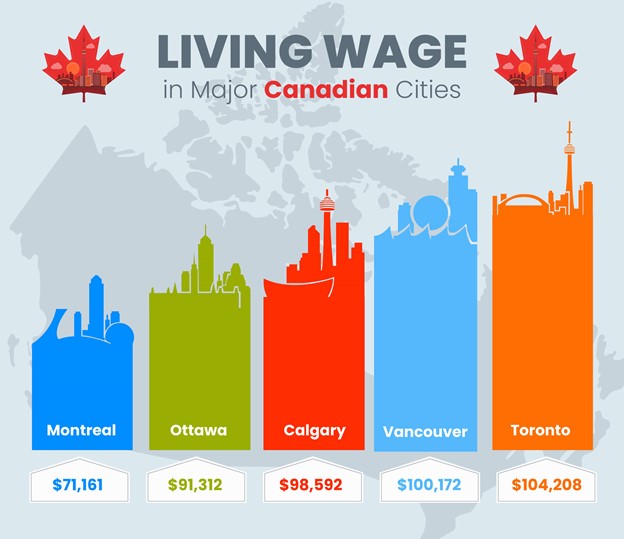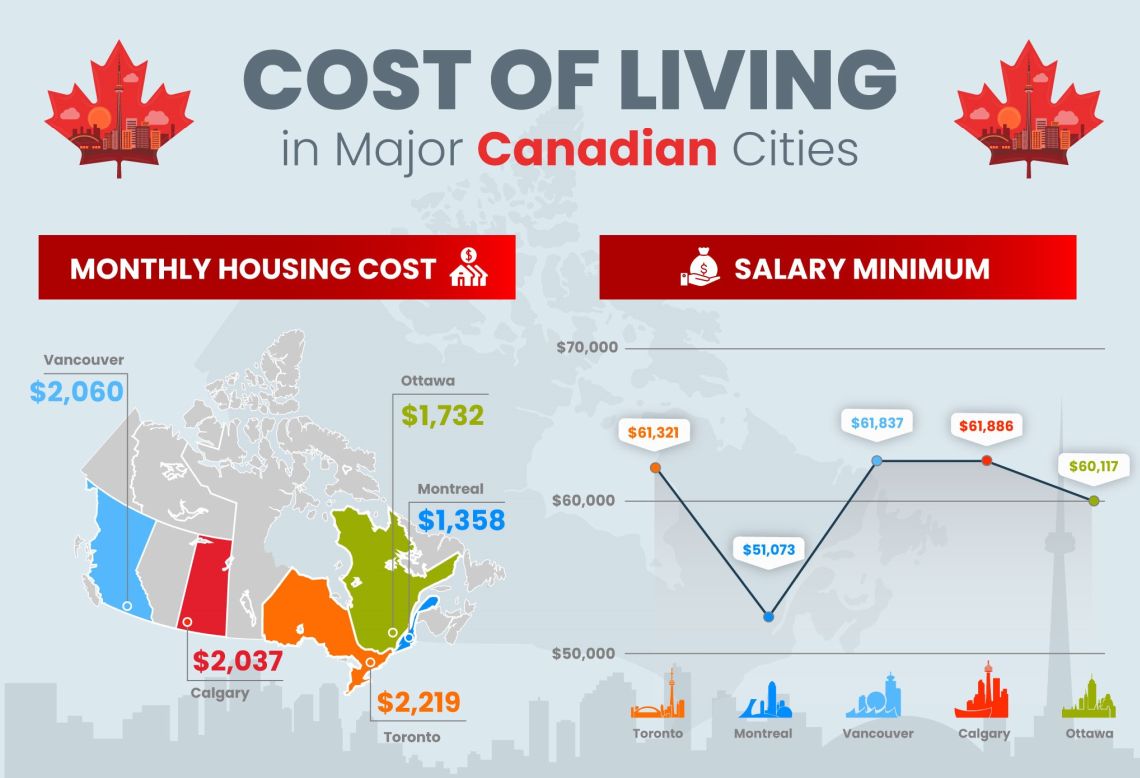With each passing day, the cost of living is becoming more expensive for Canadians. As the prices of goods and housing increase, wages often don't keep up. We understand the importance of stretching your dollar and managing your budget as prices rise, salaries stagnate, and the housing market contracts. As many people consider moving for a cheaper cost of living, it’s valuable to know the salary needed in various Canadian cities to live comfortably. To that end, we investigated the salary needed in Canadian cities to both survive and to thrive.

Toronto, Ontario
In Toronto, we found the living wage to be $104,208 for a family of four. The median cost of housing, adjusted by shelter Consumer Price Index (CPI) from 2021 is now $2,219 per month. The minimum salary needed for the year (adjusted with CPI) is $61,321.
Vancouver, British Columbia
In Vancouver, a living wage is $100,172. The median cost of housing is currently sitting at $2,060 per month. The minimum salary needed for the year (adjusted with CPI) is currently $61,837.
Calgary, Alberta
In Calgary, the living wage is presently $98,592. The median cost of housing is $2,037 per month. The minimum salary needed for the year (adjusted with CPI) sits at $61,886.
Ottawa, Ontario
In Ottawa, you’ll need a living wage of $91,312 to survive. The median cost of housing is $1,732 per month. The minimum salary needed (adjusted with CPI) stands at $60,117.
Montreal, Quebec
In Montreal, the living wage is $71,161 for a family of four. The median cost of housing cost; is $1,358 per month. The minimum salary needed, for the current year (adjusted with CPI) is $51,073.
Living Wage in Canada:
|
City |
Living Wage |
Salary Minimum |
Housing Cost |
|
Toronto |
$104,208 |
$61,321 |
$2,219 |
|
Vancouver |
$100,172 |
$61,837 |
$2,060 |
|
Calgary |
$98,592 |
$61,886 |
$2,037 |
|
Ottawa |
$91,312 |
$60,117 |
$1,732 |
|
Montreal |
$71,161 |
$51,073 |
$1,358 |
Nationwide, Canada’s median yearly full-time personal income is $62,420 as of 2023, whereas the average household expenditure is $72,940, adjusted from 2021 by CPI. The poverty line, or minimum salary needed across Canada, adjusted from 2022 by CPI, is $49,992.
On average, households are spending more than they earn.
The cost of groceries and eating at restaurants in major Canadian cities is fairly consistent, with a few fluctuations based on various taxes and transportation factors. The average cost of food expenditures for a household for a month adjusted by CPI from 2021 includes groceries ($774) and eating out ($207).

Our study uses various data sets from Statistics Canada. Market Basket Measure (MBM) defines the poverty line based on the “cost of a basket of food, clothing, shelter, transportation, and other items for a family of four.” Other data sources to determine the living wage in each city include Ontario Living Wage, IRIS (Quebec), Policy Alternatives (Vancouver), and Living Wage Alberta.
Canada’s Consumer Price Index (CPI)is considered the most accurate measure of inflation as it reflects consumer spending habits, thus playing a crucial role in determining the income required for a sustainable lifestyle. The CPI is based on “food; shelter; household operations, furnishings and equipment; clothing and footwear; transportation; health and personal care; recreation, education and reading; and alcoholic beverages, tobacco products, and recreational cannabis.”
The CPI rose 2.9 per cent year on year in January 2024, after an increase of 5.9 per cent in the prior period. The CPI of “shelter” or housing costs rose 6.2 per cent in January 2024, and 6.6 per cent in the prior period, putting the squeeze on the cost of housing affordability. For groceries, there was an increase of 3.4 per cent in January 2024, and 11.4 per cent in 2023. Similarly, the cost of eating out also rose 5.1 per cent in 2024 and by 8.2 per cent in 2023.
While the CPI varies from city to city we use the nationwide averages in our calculations. The study only takes into account a household of two adults and two children, so other household configurations will have different costs. For instance, single households, while spending less on most items, will need to spend more of their income on housing if not sharing with others.
Sign Up To Our Newsletter To Take Advantage Of Our Fantastic Offers.